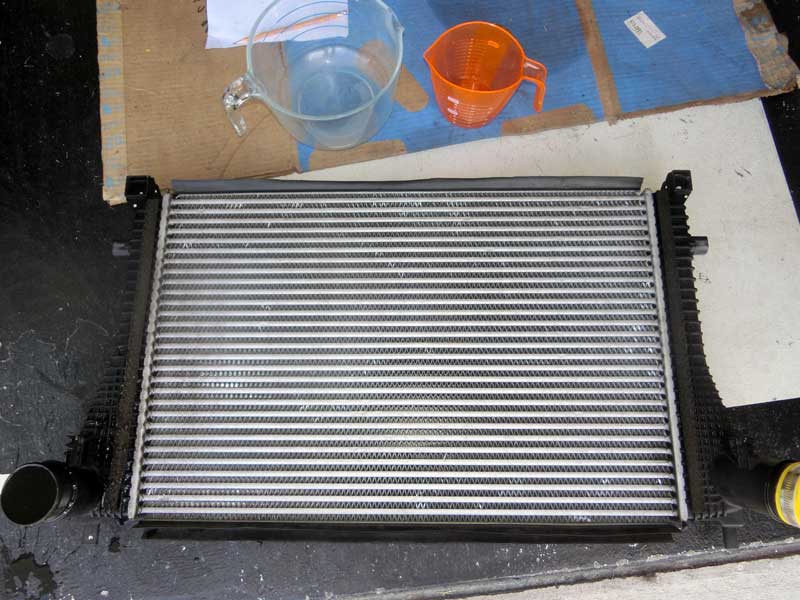A common measurement to describe intercoolers is the volume. Usually this is derived by taking the core dimensions; length, depth, and height, and multiplying them to get volume.
This method falls short in terms of accuracy because it fails to address all of open space that the core is comprised of. Previously I had measured the internal volume of the eBay direct fit intercooler and with a stock Mk7 GTI intercooler available I went about measuring the internal volume of this core and end tanks.

To measure the volume one of the end tanks is capped off and the entire internal volume of the intercooler is filled with water. The water is then poured out measuring the quantity that was needed to fill the intercooler.
The Mk7 GTI Stock Intercooler including end tanks holds 258 cubic inches of water.
By comparison, using the core length, width, and height method produces a core volume of 493 cubic inches.
Turbo Lag
Comparing the results from the stock GTI intercooler to eBay intercooler provides for an opportunity to assess how likely it is that changing from the stock to aftermarket intercooler is to introduce turbocharger lag.
A commonly expressed fear is that the larger intercooler, with larger volume, will take longer for the turbocharger to “fill” and therefore cause turbo lag.
Putting some perspective to this involves some simple calculations and conservative assumptions using information about the Mk7 GTI engine and the volume change when swapping intercoolers.
The GTI engine is approximately 2 liters and when turning at 2000 rpm out of boost is flowing roughly 56 cubic feet per minute. This works out to be 1,613 cubic inches per second.
The additional volume created by the larger eBay intercooler is 103 cubic inches. That is, the eBay core has an internal volume that is 103 cubic inches greater than the stock GTI intercooler.
So the question then is, if there is an “extra” 103 cubic inches to fill, how long does that take? If it takes a while then maybe the larger core could cause turbo lag.
It turns out that at 2000 rpm and no boost the extra volume takes 0.06 seconds to fill.
Conclusion
It is unlikely that installing the eBay direct fit intercooler in place of the stock GTI intercooler is going to lead to perceptible turbocharger lag. The added volume created by the eBay core takes an extra six one hundredths of a second to fill when the engine is operating at 2000 rpm.


People forget that the intercooler is already “full” at all times. It’s never in vacuum. So all that happens is a pressure rise as the turbo produces more air than the engine can ingest. This takes too little time to register in any measurements.
Yup, I wanted to figure out just how much of a volume difference there is to help illustrate how insignificant the change in volume is to boost pressure building.